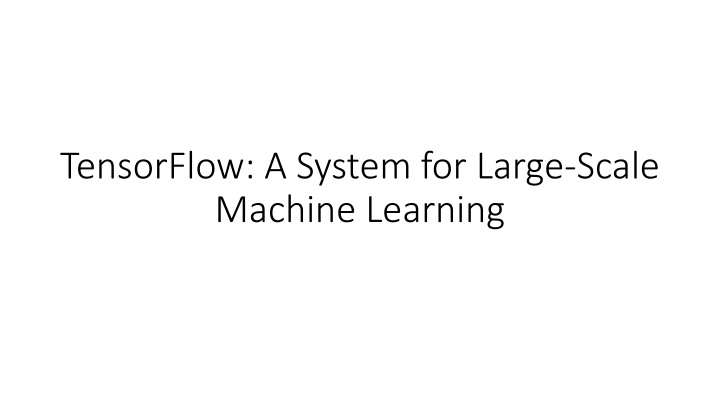
TensorFlow: Large-Scale Machine Learning Insights
Explore the challenges of training deep neural networks limited by GPU memory, the trend towards distributed training for large-scale models, and the benefits of TensorFlow's flexible dataflow-based programming model for machine learning. Dive into key concepts such as parameter servers, distributed training abstractions, and the complexities of managing state in large models. Discover how TensorFlow enables efficient computation in both training and inference stages.
Download Presentation

Please find below an Image/Link to download the presentation.
The content on the website is provided AS IS for your information and personal use only. It may not be sold, licensed, or shared on other websites without obtaining consent from the author. If you encounter any issues during the download, it is possible that the publisher has removed the file from their server.
You are allowed to download the files provided on this website for personal or commercial use, subject to the condition that they are used lawfully. All files are the property of their respective owners.
The content on the website is provided AS IS for your information and personal use only. It may not be sold, licensed, or shared on other websites without obtaining consent from the author.
E N D
Presentation Transcript
TensorFlow: A System for Large-Scale Machine Learning
Background: Training deep neural networks Limited by GPU memory using Nvidia GTX 580 (3GB RAM) 60M Parameters ~ 240 MB Need to cache activation maps for backpropagation Batch size = 128 128 * (227*227*3 + 55*55*96*2 + 96*27*27 + 256*27*27*2 + 256*13*13 + 13*13*384 + 384*13*13 + 256*13*13 + 4096 + 4096 + 1000) Parameters ~ 718MB That assuming no overhead and single precision values Tuned splitting across GPUS to balance communication and computation
Background: Training deep neural networks Limited by GPU memory using Nvidia GTX 580 (3GB RAM) 60M Parameters ~ 240 MB Need to cache activation maps for backpropagation Batch size = 128 128 * (227*227*3 + 55*55*96*2 + 96*27*27 + 256*27*27*2 + 256*13*13 + 13*13*384 + 384*13*13 + 256*13*13 + 4096 + 4096 + 1000) Parameters ~ 718MB That assuming no overhead and single precision values Tuned splitting across GPUS to balance communication and computation T Too much manual effort!
Background: Training deep neural networks Trend towards distributed training for large-scale models Parameter server: A shared key-value storage abstraction for distributed training E.g., DistBelief, Project Adam
Background: Training deep neural networks Hides details of distribution Trend towards distributed training for large-scale models But still difficult to reason about end-to-end structure Inflexible update mechanisms and state management Parameter server: A shared key-value storage abstraction for distributed training E.g., DistBelief, Project Adam T
TensorFlow Flexible dataflow-based programming model for machine learning Dataflow captures natural structure of computation in both training and inference
What is the problem being solved? Lack of a flexible programming model to build machine learning models Prior approaches restricted innovation due to their inflexibility E.g., parameter updates in parameter server-based approaches
Dataflow-based programming model Computation structured as a dataflow graph Nodes can be stateful Captures accumulated state as part of the training process E.g., parameter values Graph elements Tensors flow across edges between nodes Operations are expressions over tensors (e.g., constants, matrix multiplication, add) Variables can accumulate state Queues provide explicit advanced coordination
What are the metrics of success? Variety of specialized extensions built over the framework User level code Acceptable performance with respect to state-of-the-art
Extensibility Optimization algorithms Momentum, AdaGrad, AdaDelta, Adam E.g., parameter updates in momentum are based on accumulated state over multiple iterations Difficult to implement extensible optimization algorithms in parameter servers
Extensibility Sharding very large models E.g., Sparse embedding layers Shard embedding layer across parameter server tasks Encode incoming indices as tensors, and ship to the appropriate shard
Extensibility Use queues to coordinate the execution of workers Synchronous replication Straggler mitigation with backup workers
Key results Extensibility matters!
Key results Extensibility matters!
Limitations and scope for improvement TF s high-level programming model is tightly coupled with its execution model Translate TF programs to more efficient executables using compilation to hide translation TF dataflow graphs are static Key runtime decisions, such as number of PS shards, seem to require manual specification Can these be automatically deduced based on workload characteristics?
